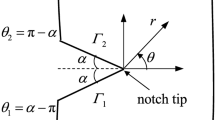Summary
Elastoplastic solutions with the higher-order terms for V-notches in materials exhibiting pressure-sensitive yielding and plastic volumetric deformations are presented. It is shown that under plane strain conditions the variable-separable solution exists within some limited pressure-sensitivities. The limit values grow significantly with increasing notch angle. The leading singularity is a decreasing function of notch angle. The small notch angle can hardly affect the singularity. The plane stress fields are generally more singular than the plane strain ones under the same conditions. The pressure-sensitivity does not affect the plane strain field singularity, but the angular stress distributions. The plane stress singularity is slightly increased by the high pressure-sensitivities at the large notch angles. The second-order exponent grows significantly with increasing notch angle. At a notch angle greater than 60°, the elasticity enters the second-order terms in all materials under plane strain conditions, while the plane stress second-order solutions contain the elasticity effects for all notches. It implies that the second-order terms in the notch analysis may not give a significant improvement in characterising the full stress fields. For an apex notch bounded to a rigid substrate, the leading-order singularity falls with increasing notch angle more slowly than that in the homogeneous pressure-sensitive materials. It vanishes at a notch angle of about 125° for all strain-hardening exponents. The elasticity affects the second-order solutions when notch angle becomes large. Whereas the stress fields are dominated by the hoop stress under assumptions of the traction-free crack surfaces, the shear stress is significant for large angle notches.
Similar content being viewed by others
References
Williams, M. L.: Stress singularities resulting from various boundary conditions in angular corners of plates in extension. ASME-Transaction: J. Appl. Mech.19, 526–528 (1952).
Hutchinson, J. W.: Singular behaviour at the end of a tensile crack in a hardening material. J. Mech. Phys. Solids16, 13–31 (1968).
Rice, J. R., Rosengren, G. F.: Plane strain deformation near a crack tip in a power-law hardening material. J. Mech. Phys. Solids16, 1–12 (1968).
Li, Y. C., Wang, T. C.: High-order asymptotic field of tensile plane-strain nonlinear crack problems. Sci. Ser. A29, 941–955 (1986).
Xia, L., Wang, T. C., Shih, C. F.: Higher-order analysis of crack-tip fields in elastic power-law hardening materials. J. Mech. Phys. Solids41, 665–687 (1993).
Kuang, Z.-B., Xu, X.-P.: Stress and strain fields at the tip of a sharp V-notch in a power-hardening material. Int. J. Fracture35, 39–53 (1987).
Atkinson, C., Bastero, J. M., Martinez-Esnaola, J. M.: Stress analysis in sharp angular notches using auxiliary fields. Eng. Fracture Mech.31, 637–646 (1988).
Yuan, H., Lin, G.: Analysis of elastoplastic sharp notches. Int. J. Fracture67, 187–216 (1994).
Drucker, D. C., Prager, W.: Soil mechanics and plastic analysis and limit design. Q. Appl. Math.10, 157–165 (1952).
Rudnicki, J. W., Rice, J. R.: Conditions for the localization of deformation in pressure-sensitive dilatant materials. J. Mech. Phys. Solids23, 371–394 (1975).
Lance, G., Nemat-Nasser, S.: Slip-induced plastic flow of geomaterials and crystals. Mech. Materials5, 1–11 (1986).
Nemat-Nasser, S., Mehrabadi, M. M., Iwakuma, T.: On certain macroscopic and microscopic aspects of plastic flow of ductile materials. In: Three-dimensional constitutive relations and ductile fracture (Nemat-Nasser, s., ed.), pp. 157–172. Amsterdam: North-Holland 1981.
Spitzig, W. A., Richmond, O.: Effect of hydrostatic pressure on the deformation behaviour of polyethylene and polycarbonate in tension and in compression. Polymer Eng. Sci.19, 1129–1139 (1979).
Sue, H.-J., Yee, A. F.: Toughening mechanisms in a multi-phase alloy of nylon 6,6/polyphenylene oxide. J. Materials Sci.24, 1447–1457 (1989).
Chen, I.-W., Reyes Morel, P. E.: Implications of transformation plasticity in ZrO2-containing ceramics: I, Shear and dilatation effects. J. Am. Ceramics Soc.69, 181–189 (1986).
Li, F. Z., Pan, J.: Plane-strain crack-tip fields for pressure-sensitive dilatant materials. Trans. ASME J. Appl. Mech.57, 40–49 (1990).
Yuan, H., Lin, G.: Elastoplastic crack analysis for pressure-sensitive dilatant materials — Part I: Higher-order solutions and two-parameter characterization. Int. J. Fracture61, 295–330 (1993).
Yuan, H.: Elastoplastic crack analysis for pressure-sensitive dilatant materials — Part II: Interface cracks. Int. J. Fracture69, 167–187 (1994).
Rice, J. R.: A path independent integral and the approximate analysis of strain concentration by notches and cracks. Trans. ASME J. Appl. Mech.35, 379–386 (1968).
Yuan, H.: On two-parameter characterization of cracks in dilatant pressure-sensitive materials (submitted).
Dong, P., Pan, J.: Elastic-plastic analysis of cracks in pressure-sensitive materials. Int. J. Solids Struct.28, 1113–1127 (1991).
Ben-Aoun, Z. E. A., Pan, J.: Effects of elasticity and pressure-sensitive yielding on plane-stress crack-tip fields. Eng. Fracture Mech.44, 649–662 (1993).
Deuflhard, P., Bader, G.: Multiple shooting techniques revised. Technical Report 163, University of Heidelberg, SFB 123, 1982.
Yuan, H., Cornec, A.: Asymptotic analysis of steady-state crack extension of combined mode I and III in elastic-plastic materials with linear-hardening. Fracture Mechanics: Twenty-Third Symposium, ASTM STP 1189, pp. 185–207, ASTM Philadelphia 1993.
Sharma, S. M., Aravas, N.: Determination of higher-order terms in asymptotic elastoplastic crack tip solutions. J. Mech. Phys. Solids39, 1043–1072 (1991).
Author information
Authors and Affiliations
Rights and permissions
About this article
Cite this article
Yuan, H. Singular stress fields at V-notch tips in elastoplastic pressure-sensitive materials. Acta Mechanica 118, 151–170 (1996). https://doi.org/10.1007/BF01410514
Received:
Revised:
Issue Date:
DOI: https://doi.org/10.1007/BF01410514




